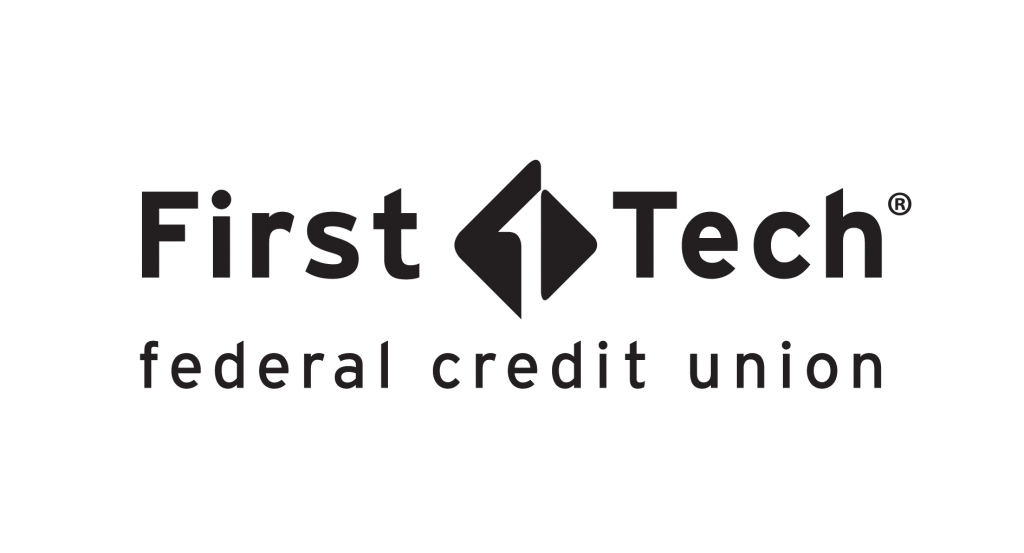
At first glance Andy van Dam's career seems a patchwork. He's made major contributions to graphics, hypermedia, courseware, electronic publishing, and teaching. But then you realize that for him, these are all facets of a single quest dating back more than 50 years: to apply the power of interactive computers to the basic ways we learn and create. And even more important, to explore these topics not off in some isolated lab—but with a rotating cast of brilliant undergraduates at the heart of a teaching university.
The grail of this quest is a vision of fully interactive documents, ones with graphics and other media we can play with, tease apart, and experiment on rather than simply study. He says he’s not quite there yet.
Andy was among the 1960s pioneers who defined the basic ways we use computers today: clickable links and word processing, interactive graphics and electronic books, graphical interfaces and flexible courseware. But where visionaries like Ted Nelson and Doug Engelbart had their eyes on global publishing or accelerating cultural evolution itself, Andy's goals were more immediate. The systems he built with and for his students solved problems one at a time, and each fed into the design of the next. But as this timeline shows, that didn't make them less influential.
When Andries van Dam was nine months old, his parents moved from their native Netherlands to Indonesia (formerly the Dutch East Indies). Soon World War II broke out. Andy and his mother were interned in a Japanese concentration camp for over three years, where malnutrition and disease killed many. His father was in an even harsher work camp. Only after the war did his parents know whether the other was alive. But when they returned to the Netherlands they discovered the rest of their extended family were victims of the Holocaust.
In 1952, Andy’s family emigrated to the United States where his father worked at Wood’s Hole Oceanographic Institution. Andy was 13. Like his parents he felt he owed it to those who had died to make the most of his opportunities. He took a string of part-time jobs in the food industry, a delight after his malnourished childhood, and asked for a typing course as a Bar Mitzvah present. With his newly acquired English language he wrote a prize-winning essay for the American Legion on why he was proud to be an American.
When he attended Swarthmore College, Andy met two fellow students who would change his life: his future wife Debbie and an older student, Ted Nelson, who would pioneer hypertext. Ted cast Andy and Debbie in his student show, likely the first rock opera.
In 1960, Andy began graduate work at the University of Pennsylvania, first in electronics and then on computerized information retrieval within the newly formed computer science department. But then he saw a film about Ivan Sutherland's groundbreaking graphics program, Sketchpad, and he switched to computer graphics for his doctorate.
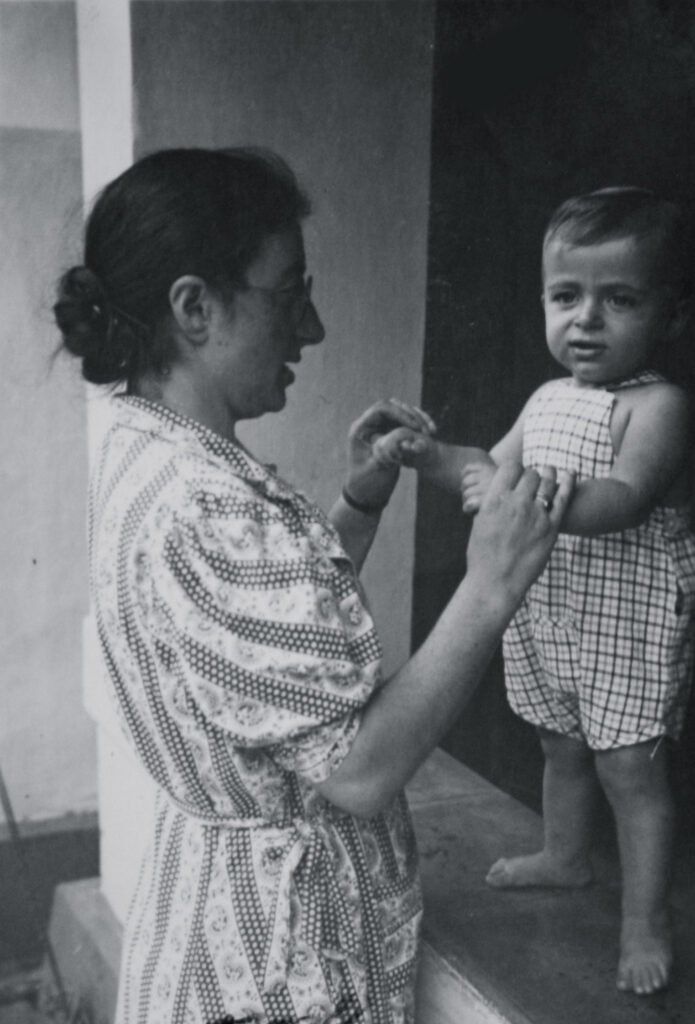
Andy as a toddler with his mother in Jakarta, 1940. His parents had moved there from the Netherlands for his father’s job as a marine biologist but were then caught up by the Japanese occupation. Courtesy Andy van Dam
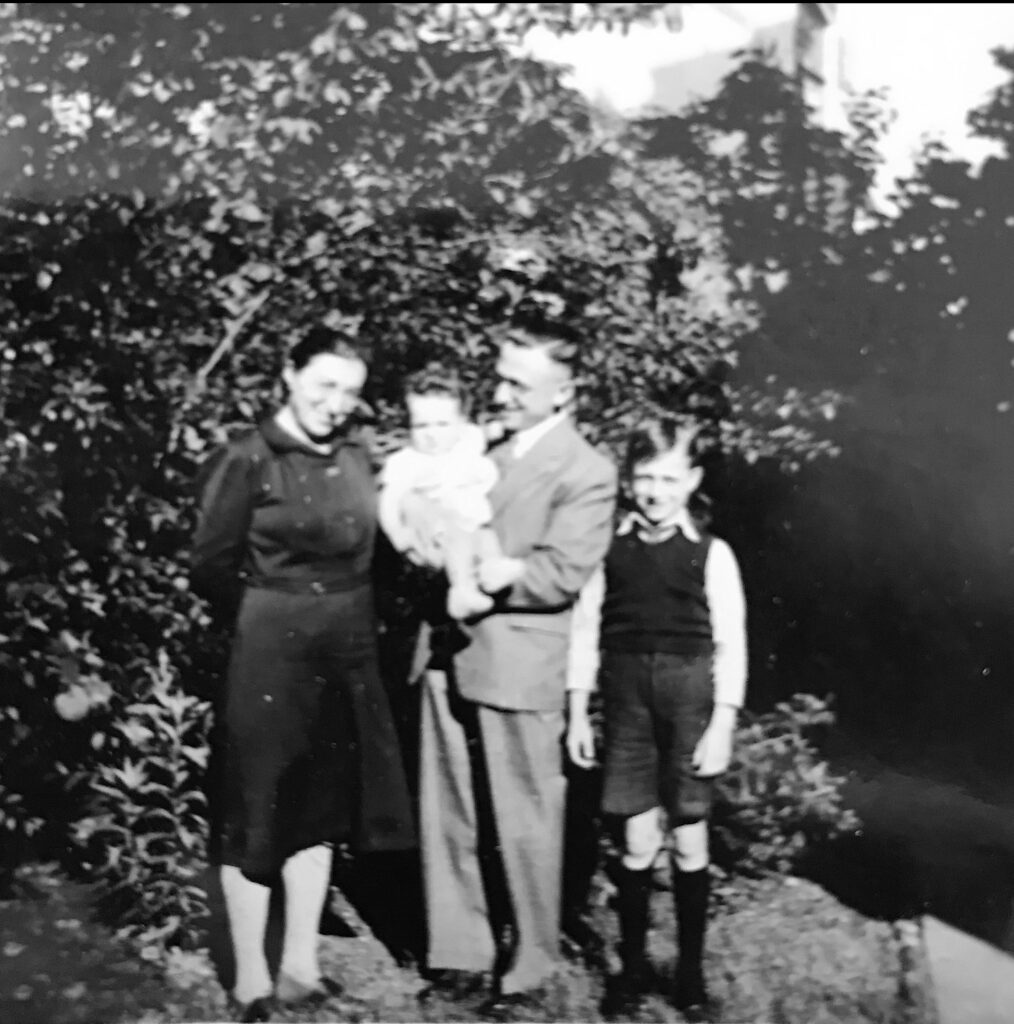
Andy (right) with his parents and baby sister in the Netherlands, 1948. They were part of a tiny postwar Jewish community, and Andy's parents fought a long legal battle to reclaim their house from Nazi collaborators who had appropriated it. Andy had to learn the basics of being a Dutch child, from traditional songs and stories to wearing uncomfortable wooden clogs. Courtesy Andy van Dam
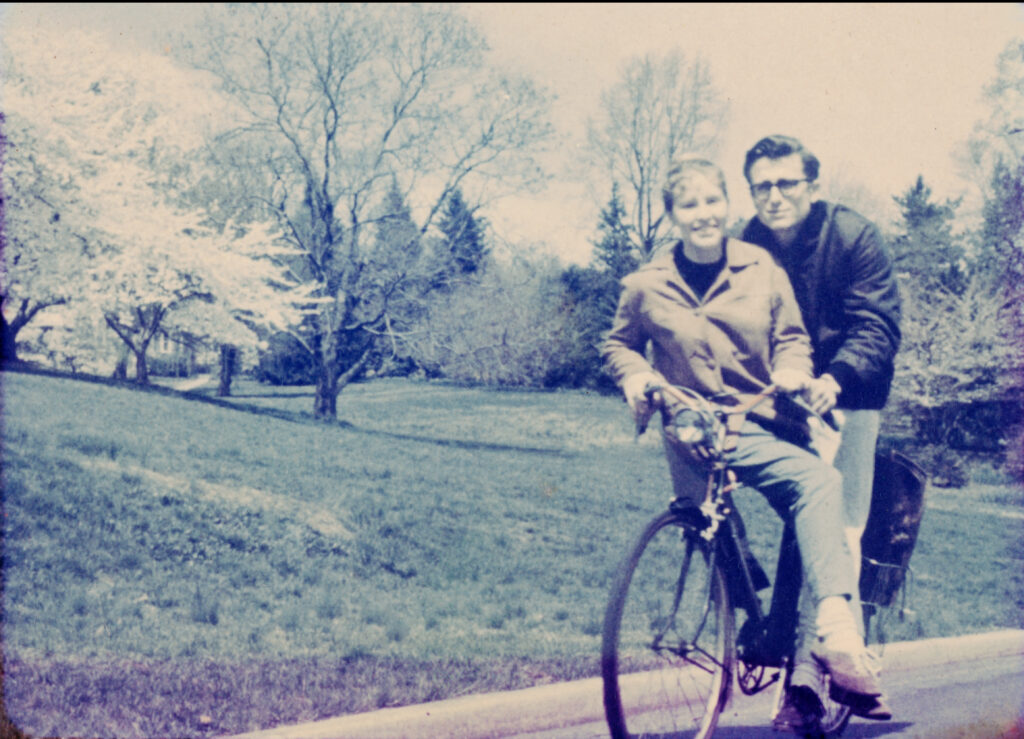
Andy and future wife Debbie on the Swarthmore campus, 1958. She studied French and would make a career teaching it as a high school subject. The couple would have three daughters. Courtesy Andy van Dam
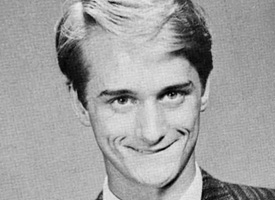
Future hypertext pioneer Ted Nelson, circa 1960. Ted's rock musical was titled "Anything and Everything." A year older than Andy, he was son of movie star Celeste Holm. Ted was bursting with ideas for everything from new kinds of movies to ways of organizing information. Swarthmore Bulletin
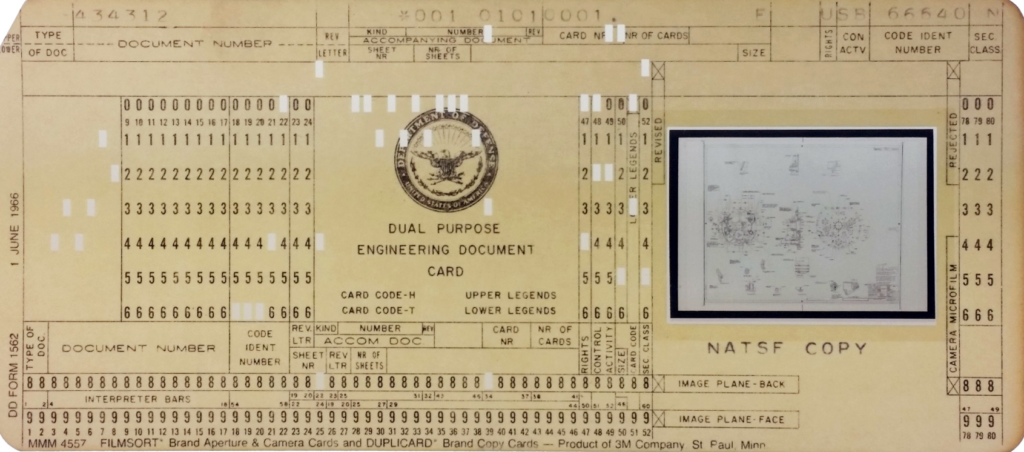
Andy's master's thesis dealt with improved schemes for sorting and searching aperture cards. These were a literal hybrid of analog and digital—microfilm embedded in a computer-sortable punched card. Large institutions used them to store millions of images in room-sized installations, from blueprints to photographs.
That year Andy saw a film about Ivan Sutherland's groundbreaking graphics program Sketchpad. It was life changing. He realized computers could bring graphics alive, and he made pictorial processing of information his dissertation topic.
Meanwhile, Andy’s wife Debbie was teaching high school French. He wondered...could he teach high school kids computing, at the time a graduate level subject? It worked, he loved teaching, and he became a professor instead of pursuing his original goal of doing research in industry.
Brown University hadn't been at the top of Andy's list. But he was impressed by the school's emphasis on teaching—the chairman of the department excused himself from Andy's interview to teach a freshman class.
Against convention, Andy began using undergraduates as teaching and research assistants, including many women. Each year's TAs would train the next. He organized skits and other fun activities for team-building.
Andy was asked by a major publisher to turn his 1966 thesis into a very early graphics textbook. But he had no time. He recruited James Foley as coauthor, and over the next decade they wrote the "bible" for hundreds of thousands of graphics students and practitioners.
In 1967 Andy co-founded the predecessor to the leading graphics professional organization SIGGRAPH. In the 1970s, Andy and his graphics students would help pioneer the first international graphics standards.
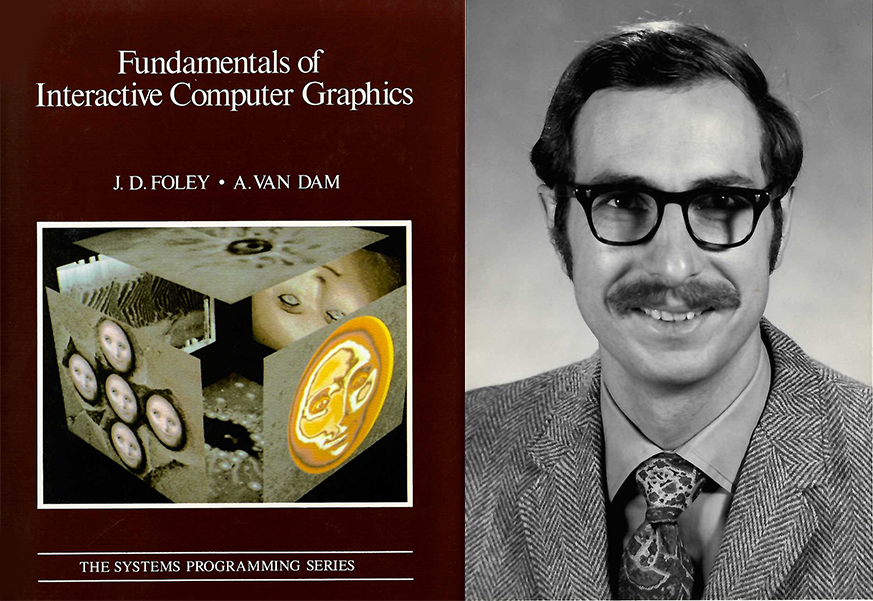
Andy was asked to turn his 1966 thesis into a very early graphics textbook, but had no time. He recruited James Foley (right) as coauthor, and over a dozen years they wrote the core text for hundreds of thousands of graphics students and practitioners. Two editions with a growing pool of coauthors would follow. Courtesy Jim Foley.
Years after attending Swarthmore, Andy and Ted Nelson reconnected at a 1967 computer conference. Ted wowed Andy with a vision of a connected world using computers—like the web today plus more. A core concept was the now familiar clickable link, which can join not just words but pictures and video too.
With Andy's undergraduates, Andy and Ted built the Hypertext Editing System (HES) in 1967, one of the very first hypertext programs as well as one of the first word processors. It was a compromise between Ted's global hypertext vision, which he called Xanadu, and Andy's wish to also develop something useful for producing printed documents. The Apollo moon program was one user.
The next year, Andy was blown away by Doug Engelbart's famous demo of his oNLine System (NLS). He got students working on a successor to HES he called FRESS, combining the best of Ted and Doug's ideas plus their own.
These were the start of 56 years—and counting—of cutting-edge projects Andy would do with his students, in effect creating an ongoing research lab powered largely by bright, motivated undergraduates guided by several doctoral and masters students. As Andy proudly says, "I've never done anything on my own. I've always relied on students."
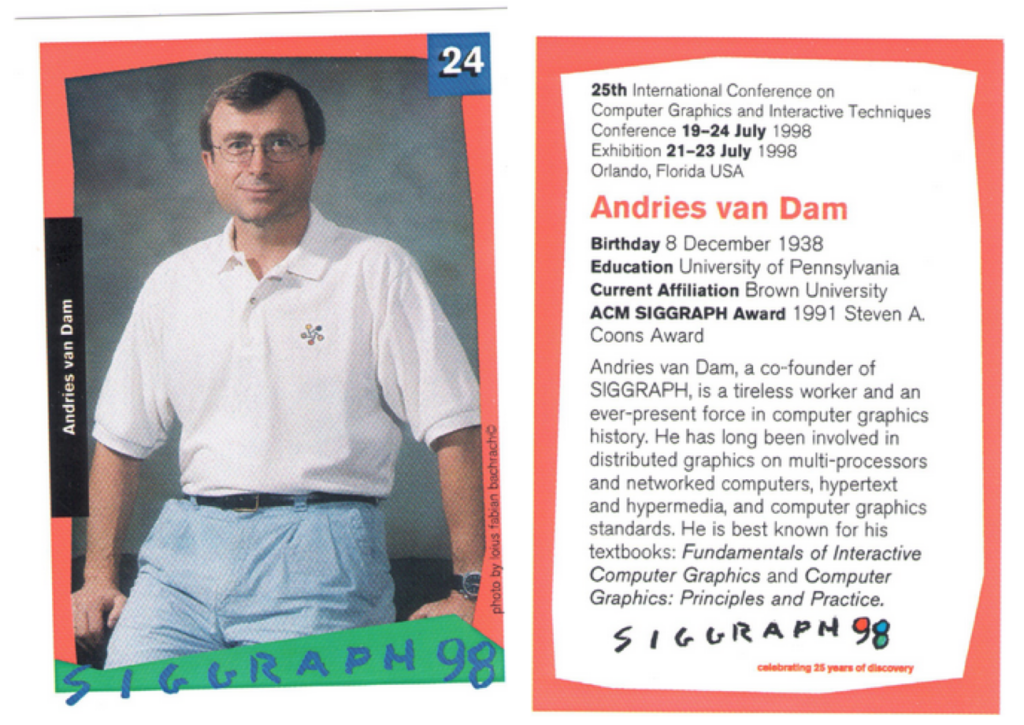
In 1967, Andy cofounded the predecessor to the leading graphics organization and conference, SIGGRAPH. His role was later recognized with this 1998 "baseball card." Courtesy Andy van Dam
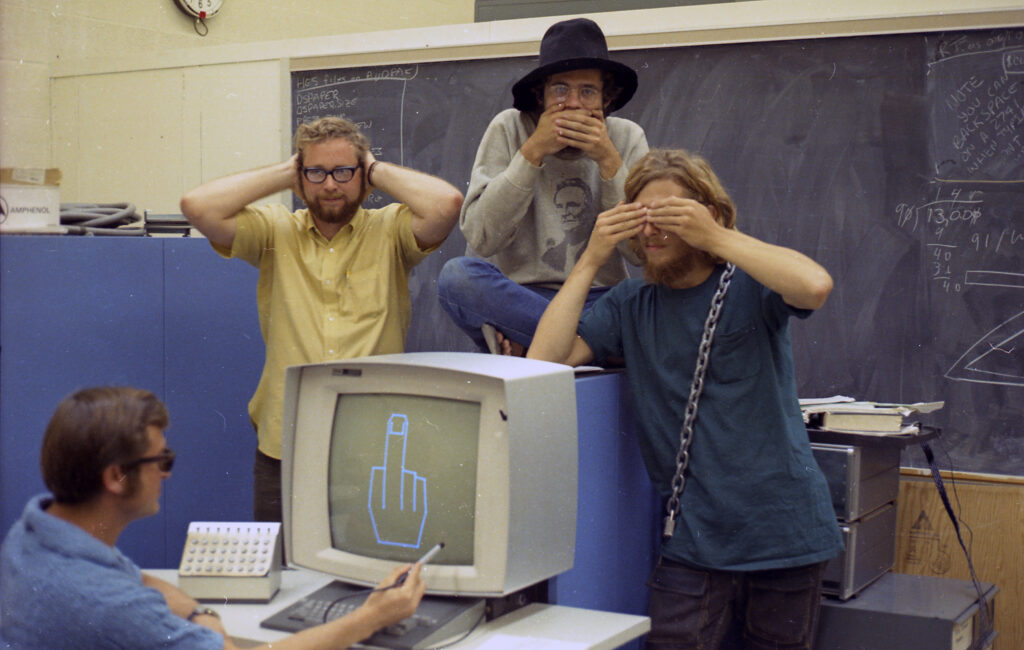
Andy at Brown with graphics terminal and star graphics students Rice, Carmody, and Gross. All three would also help create the Hypertext Editing System (HES). From the beginning, Andy had great fun with his students, both because that’s who he is as a person and because it leavens the hard intellectual work they do together. Courtesy Andy van Dam.
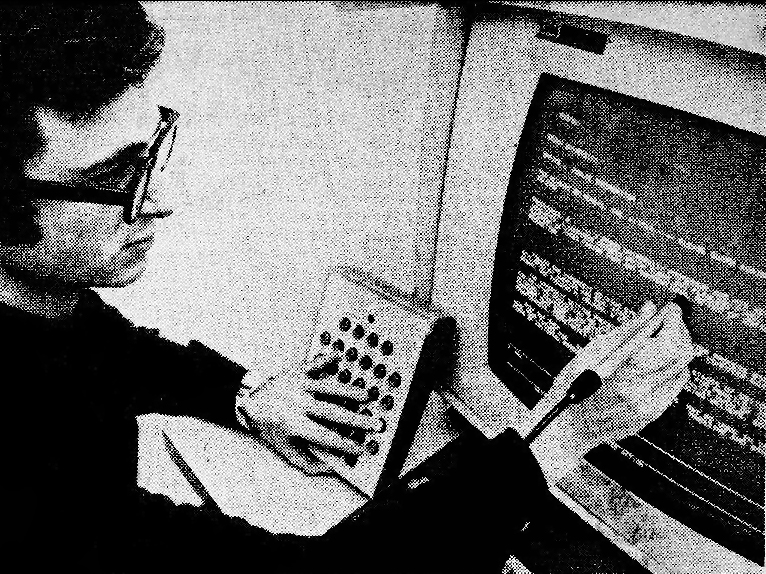
Andy demonstrating Hypertext Editing System (HES), which he and his students based on the work and help of visionary hypertext pioneer Ted Nelson. In modern terms, it felt like a word processor that also let you add and follow the kind of clickable hypertext links we use on the web. HES got newspaper and even TV coverage. Courtesy Andy van Dam
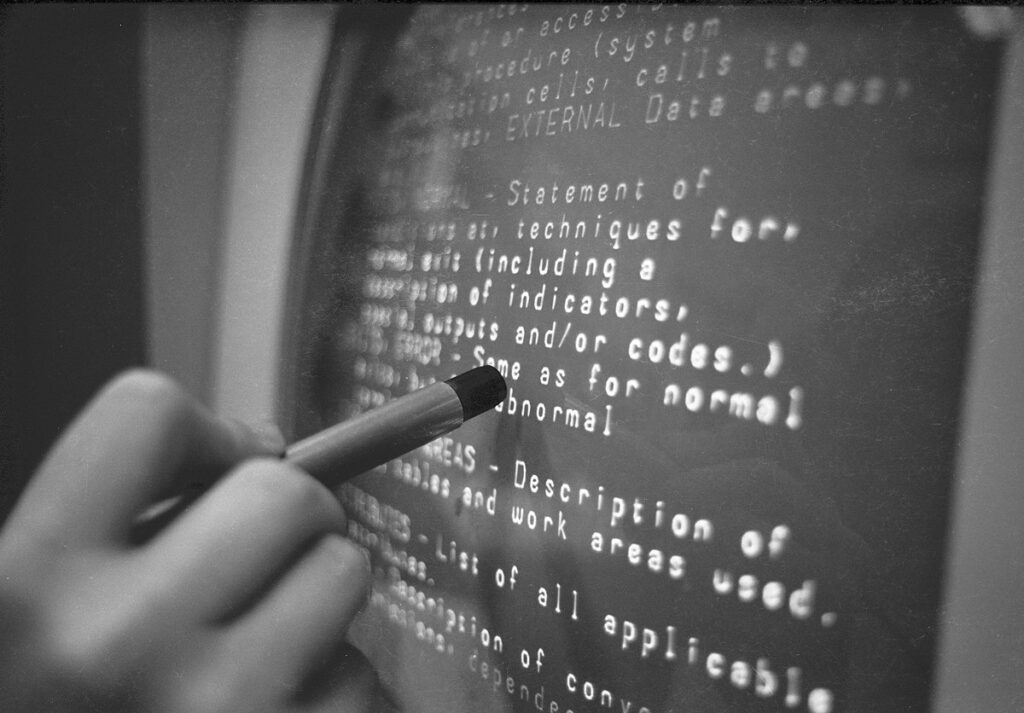
Detail of light pen on HES screen, a $200,000 (at the time!) IBM 2250 graphics terminal. Light pens served as pointing devices, like the mouse. Sponsor IBM offered to help commercialize HES, and early venture capitalists were interested, but Ted Nelson and Andy didn't reach agreement. Courtesy Norm Meyrowitz
In 1968, Andy was blown away by Doug Engelbart's demo of the futuristic features of his oNLine System (NLS): Hypertext links, videoconferencing, online collaboration, the mouse, and far more. Andy later termed it the "Mother of all Demos."
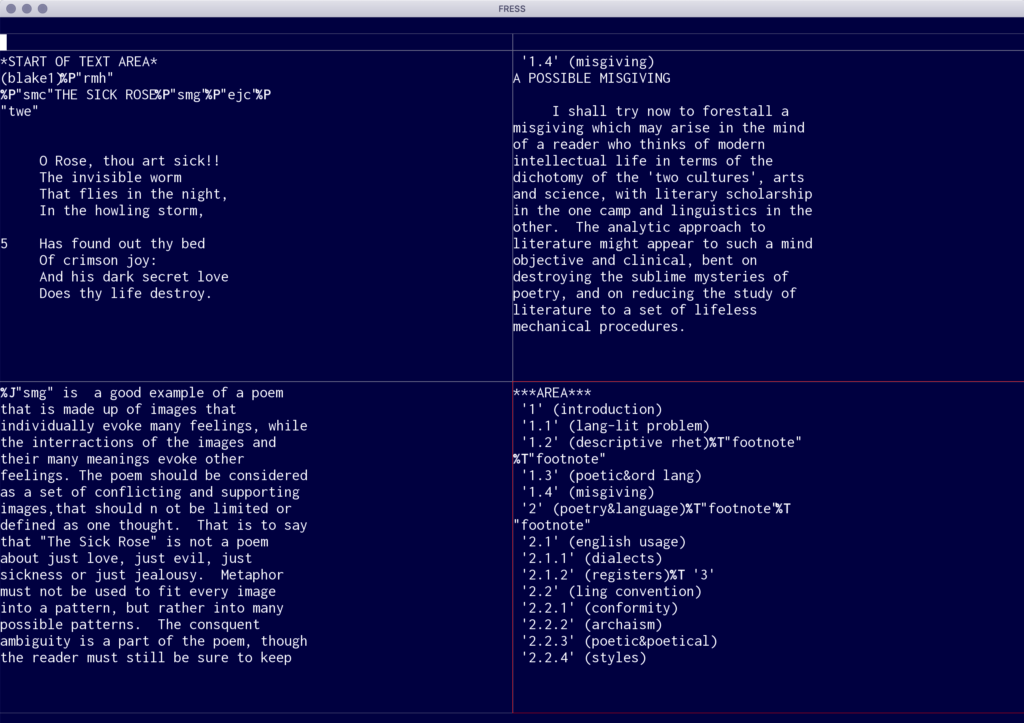
FRESS combined and extended Andy's favorite features from HES and Engelbart's NLS. The most important was to follow NLS by adding multiple users, which allowed online collaboration. FRESS had an acronym, but was really named after fresser—German/Yiddish for glutton—since it was such a memory hog. It used 128K of RAM, a quarter of the IBM mainframe’s memory! Note that this screenshot is of FRESS running in an emulator on modern equipment. Courtesy Norm Meyrowitz
When Professor Bob Scholes used FRESS to experiment with teaching poetry, the results were so good they helped kick off what was later known as "digital humanities." Students who studied and wrote about poems online rather than on paper produced more than twice as much work. Excerpt from the movie by the project's sponsor, the National Endowment for the Humanities (NEH)
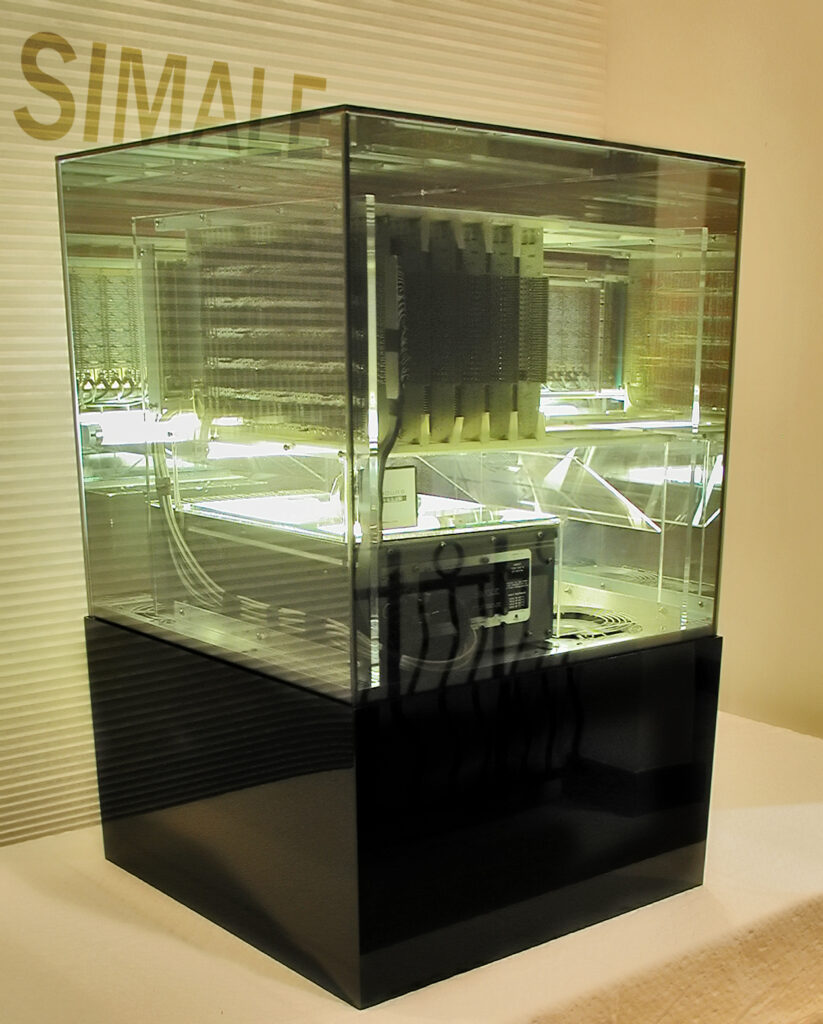
The cutting-edge Brown University Graphics System (BUGS) created by Andy and students from 1965 on included powerful custom hardware like Hal Webber's mid-1970s Simale, pictured, to quickly calculate shapes in 3D, a basic function for manipulating 3D graphics. Simale could also handle 4D, making it popular with mathematicians. Starting in the late 1970s, Andy and his students helped spearhead the first major efforts to create international standards for computer graphics. Courtesy Hal Webber
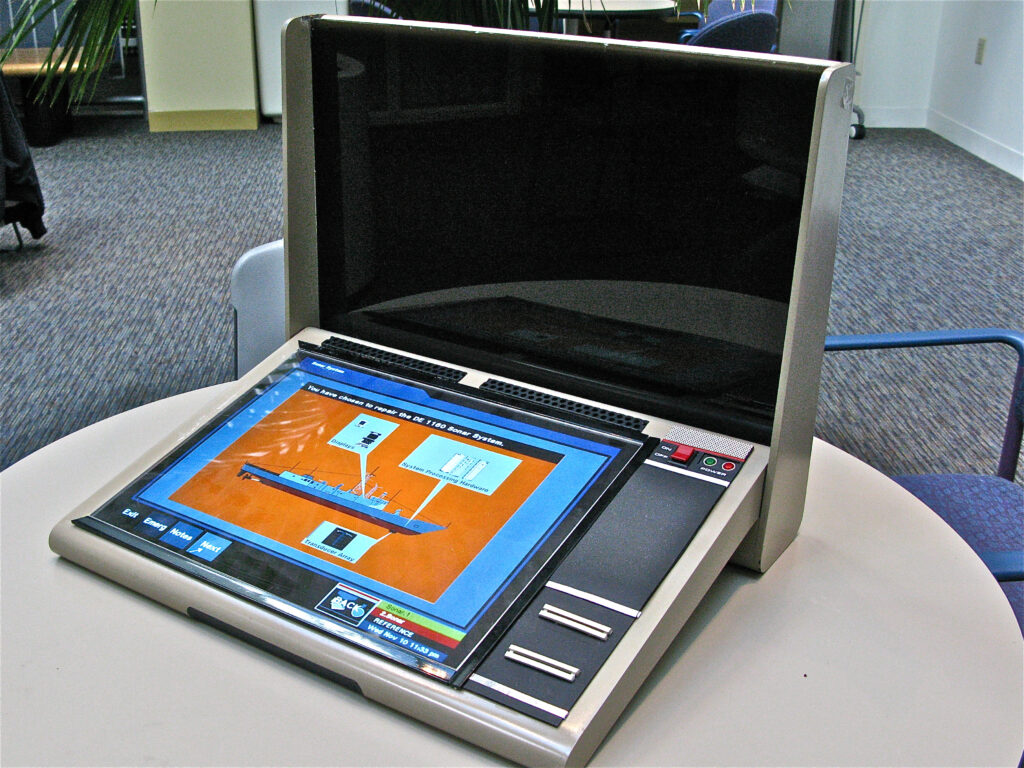
Started in the late 1970s, the Electronic Document System for Navy technicians combined visual hypertext with color graphics. Designed for teaching, it dynamically adapted its content to the student's level and progress. Pictured is the mockup for a laptop-like reader, just a bit chunkier than the Chromebook your child may take to school today. By Gregory Lloyd - Own work, CC BY-SA 3.0. https://commons.wikimedia.org/w/index.php?curid=16605568

Early workstations like Apollos offered graphical displays only found on $100,000 terminals five years before. While still pricey, they let Brown’s CS department experiment with Professor Bob Sedgewick's ideas for a fully electronic classroom, pictured—a radical idea in the early 1980s. It was the start of an initiative called the "Scholar's Workstation." Courtesy Andy van Dam
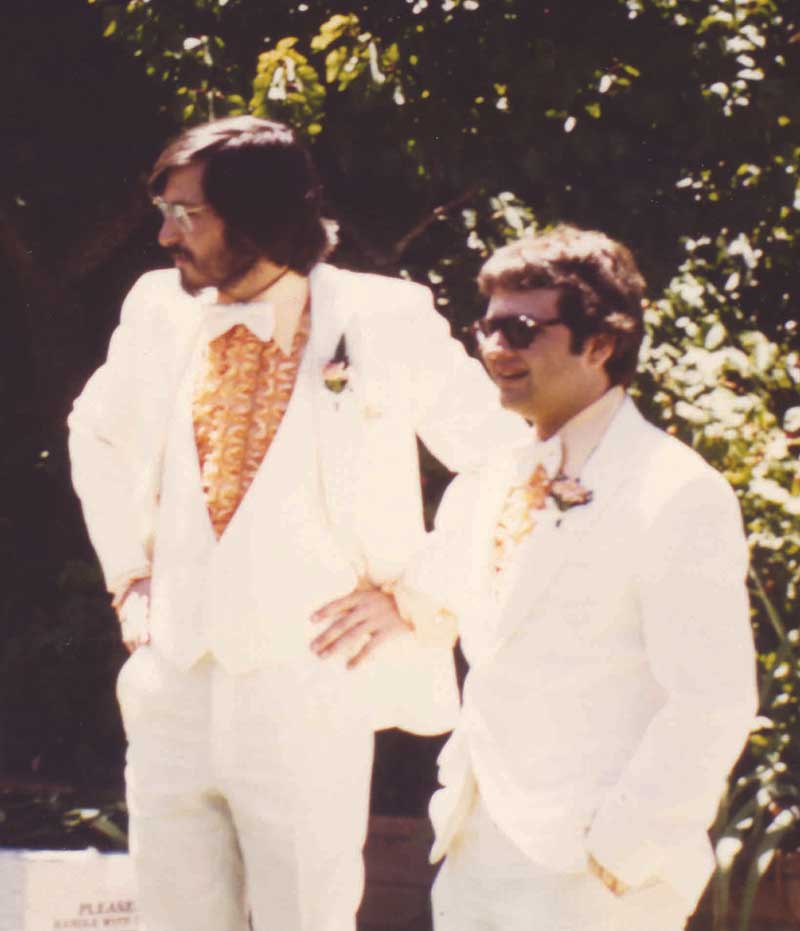
When the Apple Macintosh made graphics affordable, Andy and Norm Meyrowitz worked with CHM’s CEO Dan’l Lewin, then at Apple, to create a discount program for student purchase. Andy’s former student Andy Hertzfeld (right, at Woz's wedding) was a core Mac developer, and introduced Andy to Steve Jobs (left). They argued heatedly over the Mac's lack of networking capabilities. Courtesy Andy Hertzfeld
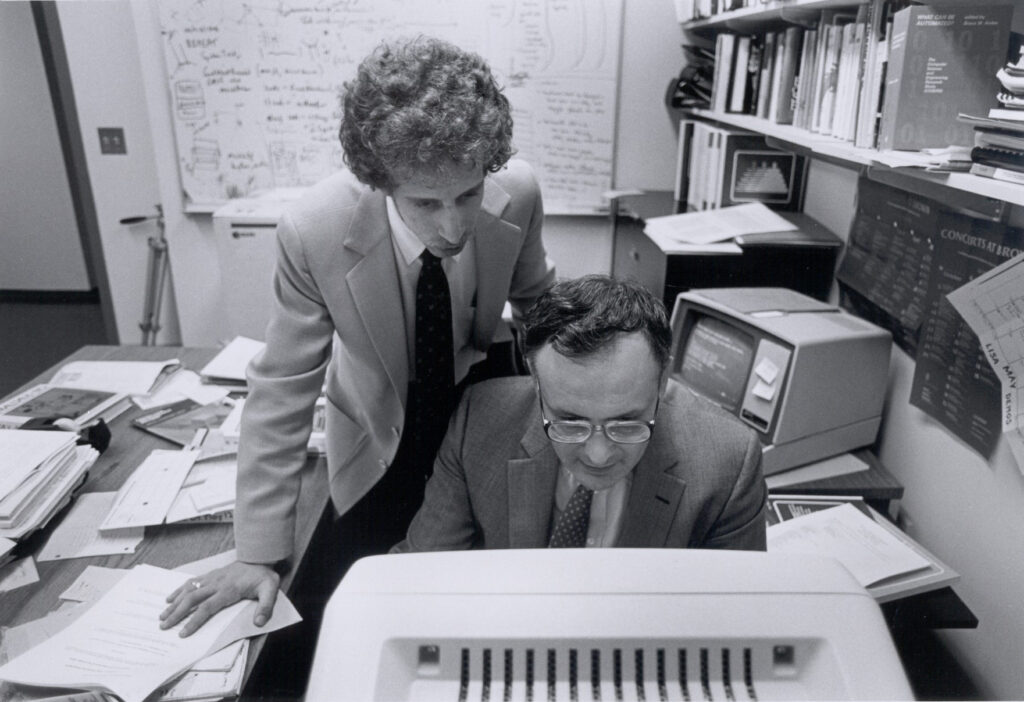
Andy cofounded IRIS (Institute for Research in Information and Scholarship) with faculty member Bill Shipp (seated) and former student Norm Meyrowitz. Their goal was bringing graphical computing to every discipline. Norm led other former students in creating hypermedia system Intermedia and later headed IRIS. Courtesy Andy van Dam
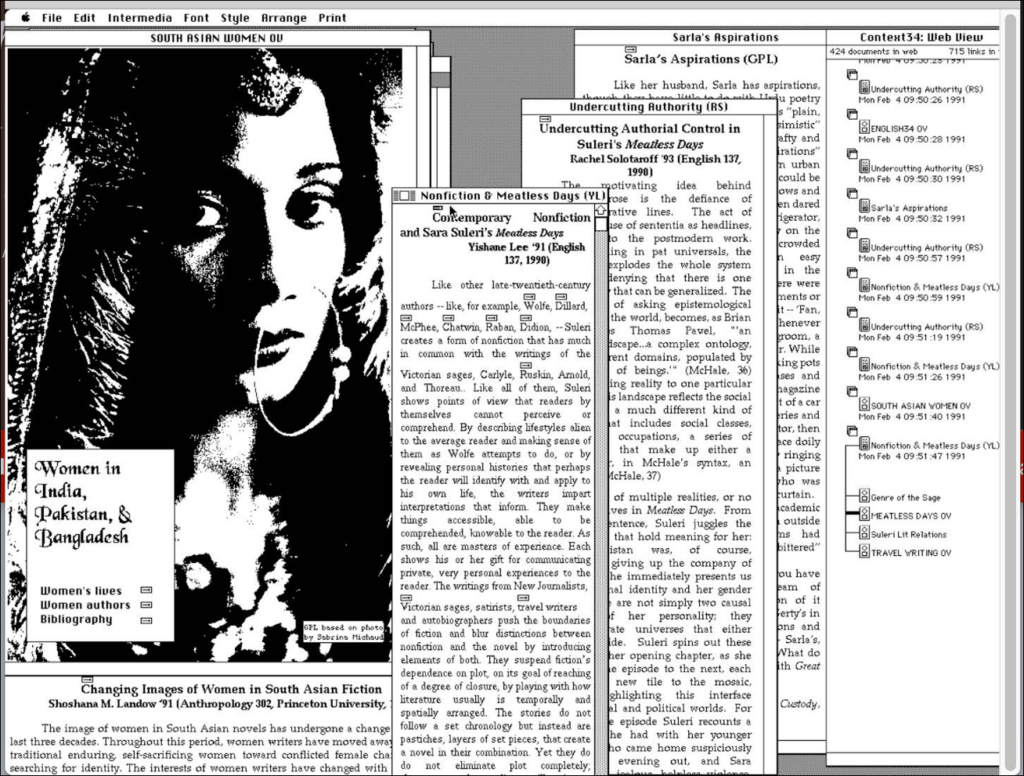
Norm Meyrowitz's cutting-edge multimedia hypertext program Intermedia was launched from IRIS. It ran under Apple UNIX on the Macintosh and inspired scholarly "webs" in English, Classics, Biology and other domains. Meyrowitz would later help pioneer Web multimedia. Courtesy Norm Meyrowitz
When the internet took off in the 1990s, the once far-out clickable link Andy and Ted Nelson had demoed in 1967 became front page news. Hypertext, in the form of the web, had gone world-wide. The web itself had risen from the 1980s hypertext community first inspired by Ted Nelson, Doug Engelbart, Andy, and his former students.
Meanwhile multimedia, which was reaching crisp maturity on ever-faster PCs with CD-ROM drives, got knocked back to whatever simple images and sounds could trickle over a squawking dialup connection.
As the world shifted, Andy's army of current and former students played various roles. One set was pivotal in the new online world, from Microsoft's Internet Explorer, to adding back multimedia with Shockwave and Flash, to helping shape the fundamental language (XML) that lies behind the pages we click on today. Others, along with Andy, turned away from the small computer screen to virtual reality, and touch interfaces, and table-sized installations.
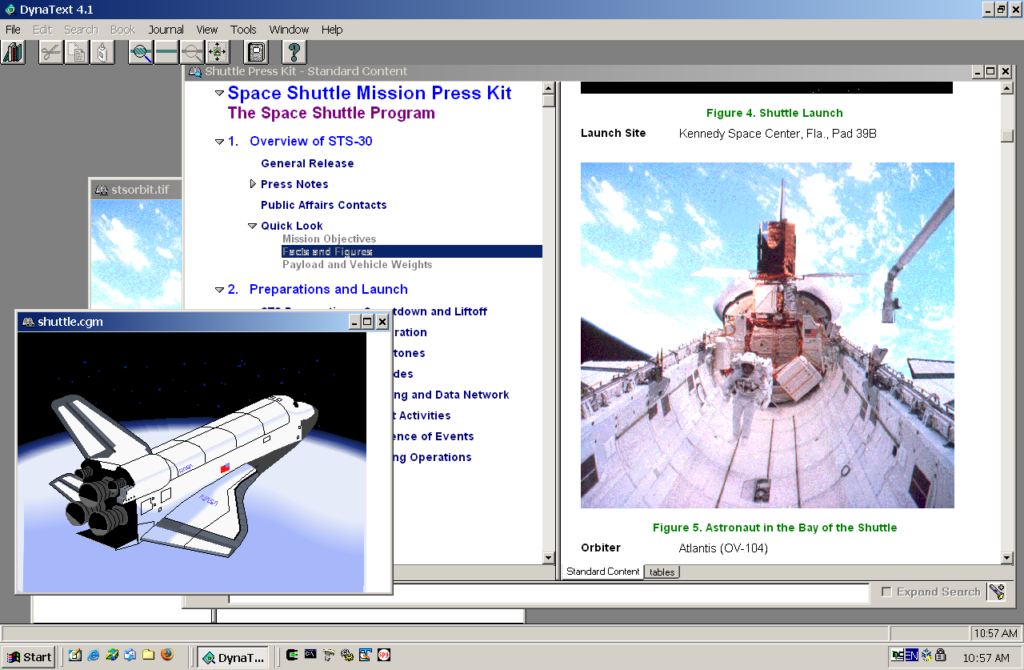
Andy has been involved in dozens of startups, most notably Electronic Book Technologies with former students Steve DeRose, Greg LLoyd, Jeff Vogel, Dave Sklar and others. EBT's products combined electronic publishing with hypertext, a novel combination at the time, and influenced XML, the language of the modern web. Courtesy Norm Meyrowitz
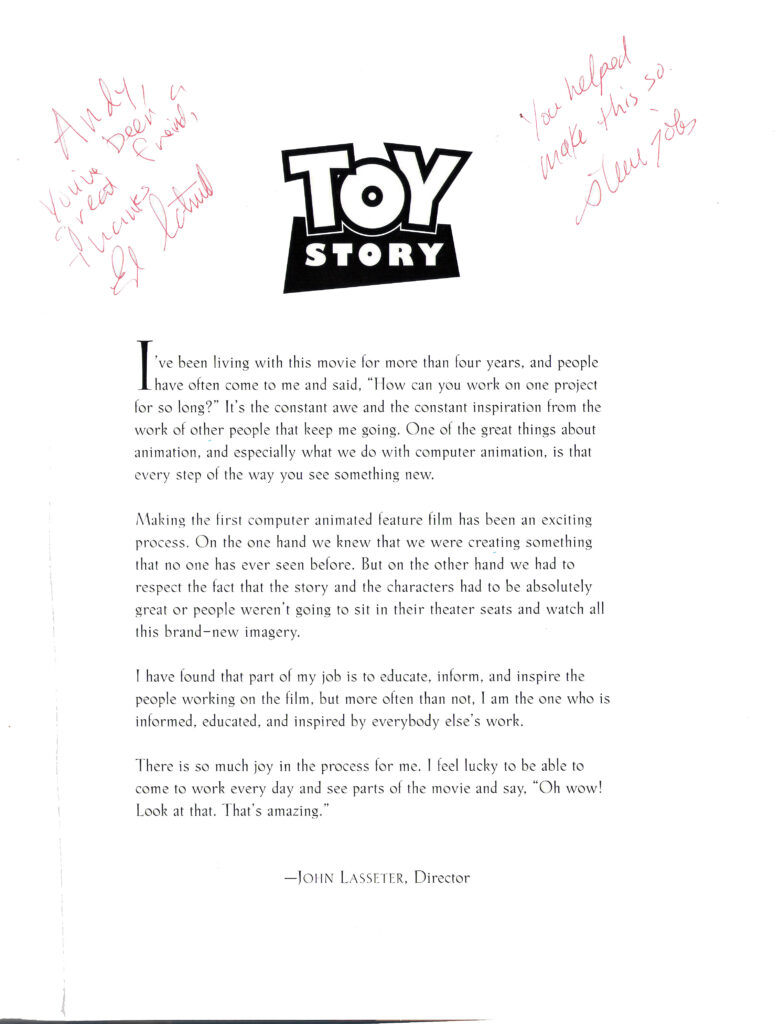
A number of Andy's students were hired by Ed Catmull, cofounder of Pixar, to do rendering software, modeling, and lighting for Toy Story and other groundbreaking films. Pixar was pivotal in the computer animation revolution of the 1980s and 1990s. On this page, Catmull and Pixar investor Steve Jobs handwrote their thanks to Andy. Courtesy Andy van Dam
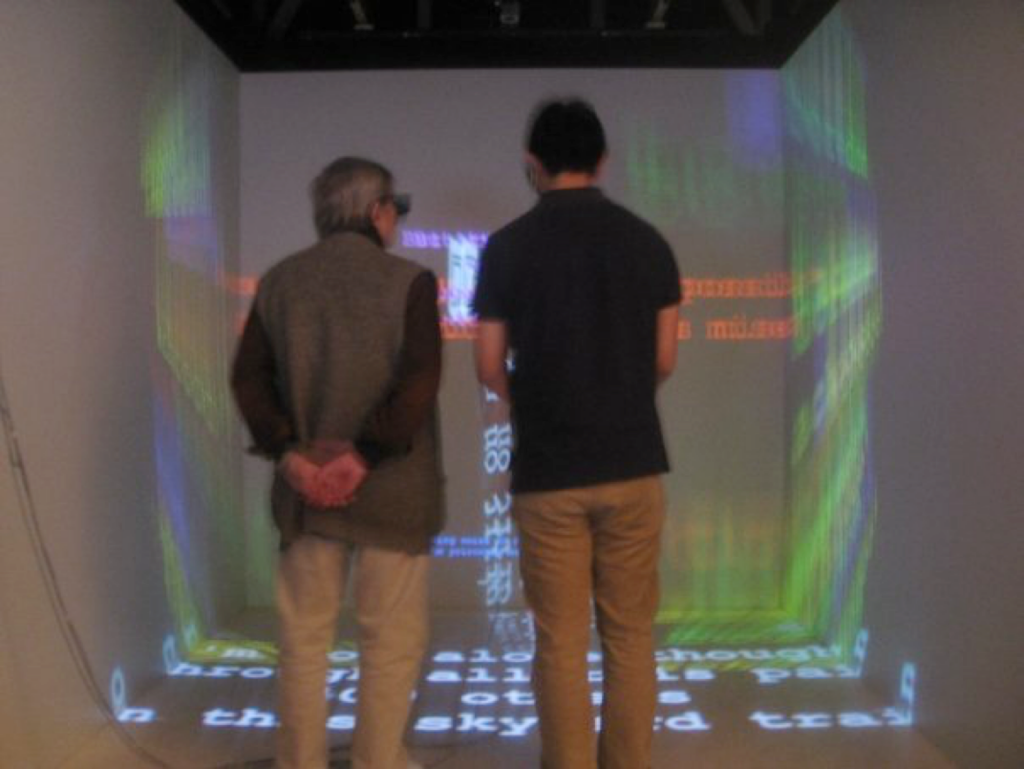
Starting in the 1980s, Intermedia and IRIS helped kick off hypertext literature at Brown and beyond. Most works remain firmly onscreen, but pictured is celebrated avant garde novelist Robert Coover (left) within an experiment in immersive 3D hypertext literature. The environment is Brown's room-sized Virtual Reality CAVE. Courtesy Norm Meyrowitz
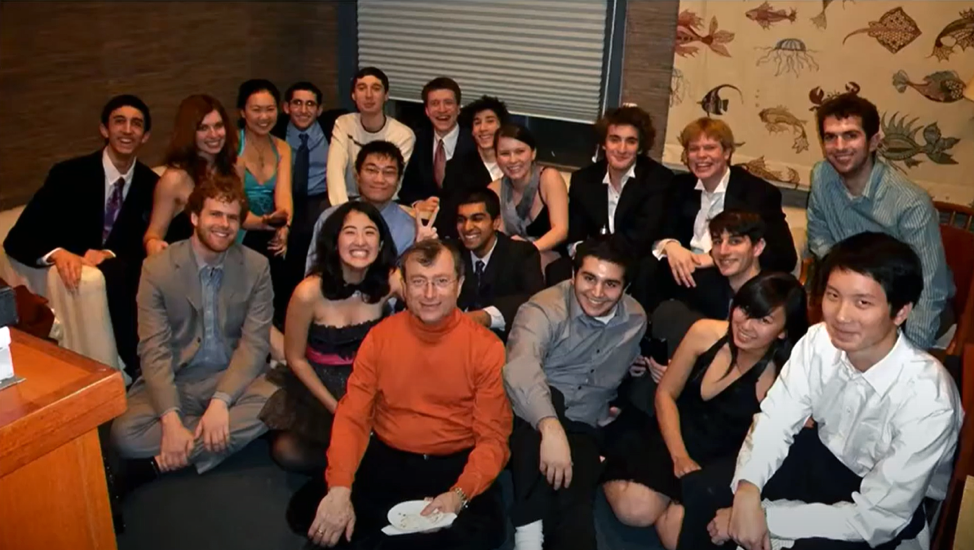
Annual teaching assistant (TA) dinner at Andy's house. In the last five years the number of TAs has doubled to 45. After 56 years, Andy's interview process for new TAs is rigorous and finely honed, but he’s also willing to take a chance on people, sometimes accepting B students who’ve worked hard. He seeks diversity in thinking as well as background. A portion of TAs go on to conduct research with Andy. Past TAs include nine heads of top CS departments, including MIT, Princeton, and the University of Washington. Courtesy Andy van Dam
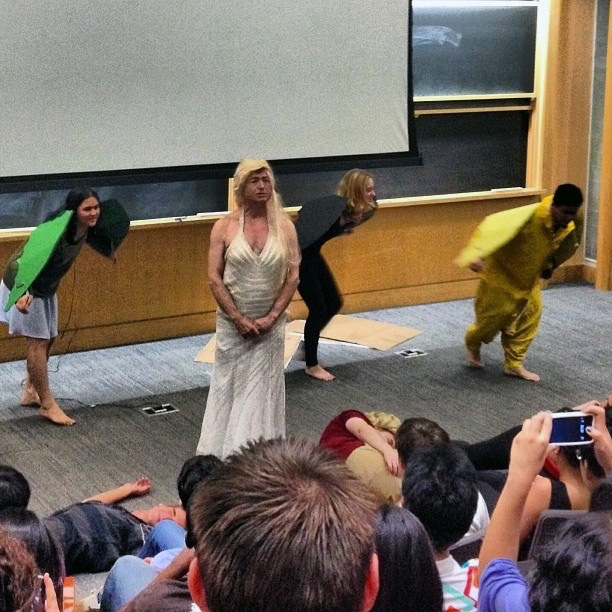
Andy as Daenerys, Mother of Dragons from the Game of Thrones series, in skit produced by teaching assistants for his introductory computer course. Andy has appeared as a witch, a rapper, and in many other roles. Courtesy Andy van Dam
Touch Art Gallery (TAG) Nobel, created by Andy and students, running on Microsoft Surface. TAG adapts visual hypertext to large scale formats like touch tables in museums. Visitors scroll, pinch, zoom, and follow links through multimedia content, including large format artworks. Andy was an advisor to Microsoft for over a decade. Courtesy Andy van Dam
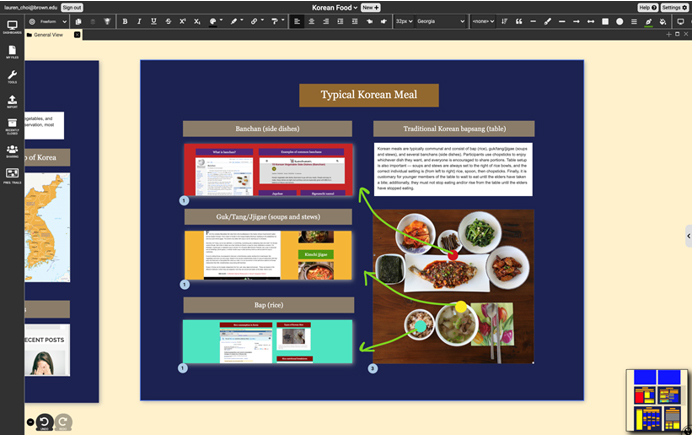
Dash is a browser-based hypermedia system Andy and students have developed since 2017, drawing on his 50 years of electronic media experience. The class Andy teaches with former student Norm Meyrowitz teaches students to create their own hypertext systems, and to learn hypermedia authoring in Dash. Courtesy Andy van Dam
When Andy started using undergraduates as teaching assistants (UTAs) and research assistants in 1965, the practice was so controversial he disguised them as "graders" for a couple of years. Five annual UTAs a year has now become 45, most helping with Andy's giant introductory course. The program has been inclusive from the start, training many hundreds of women and other underrepresented groups. Over the years, nearly half of Andy's TAs have been female..
New teaching assistants go through a rigorous interviewing and training process by Andy and the current head TAs. Shared activities like kayaking and skits make them a team. The skits started in the early 1970s and are always written and performed by the TAs for the class, sometimes with Andy as a cameo performer.
Each year, a few undergraduate TAs or RAs continue working with Andy as an advisor and mentor. And a few of those become his collaborators and friends, pushing forward efforts that have helped make Brown CS—and computing—what they are today.
Many educators learn with their students. But Andy has developed this into a way of life, running what amounts to a rolling research lab for the last 50 years largely based on undergraduates.

Andy and his wife and daughters Scuba dived as a family; he is also an avid hiker and mountain biker. Andy has explored the outdoors with generations of former students as well, backpacking the Grand Canyon in recent years. Sharing both physical and intellectual challenges is part of how he connects as a mentor. Courtesy Andy van Dam
When Andy started out in his career hypertext, graphics, and online collaboration were new. As early as the 1970s he taught about ethical issues related to computing, but going from dream to global reality brought many unintended consequences, from fake news to worries about surveillance and the digital divide.
As part of a department-wide effort Andy is now including socially responsible computing topics with every course he teaches, getting students to think about the impact on society of what they create. Together they are thinking deeply about how technologies can be more inclusive and ethical, to benefit everyone.
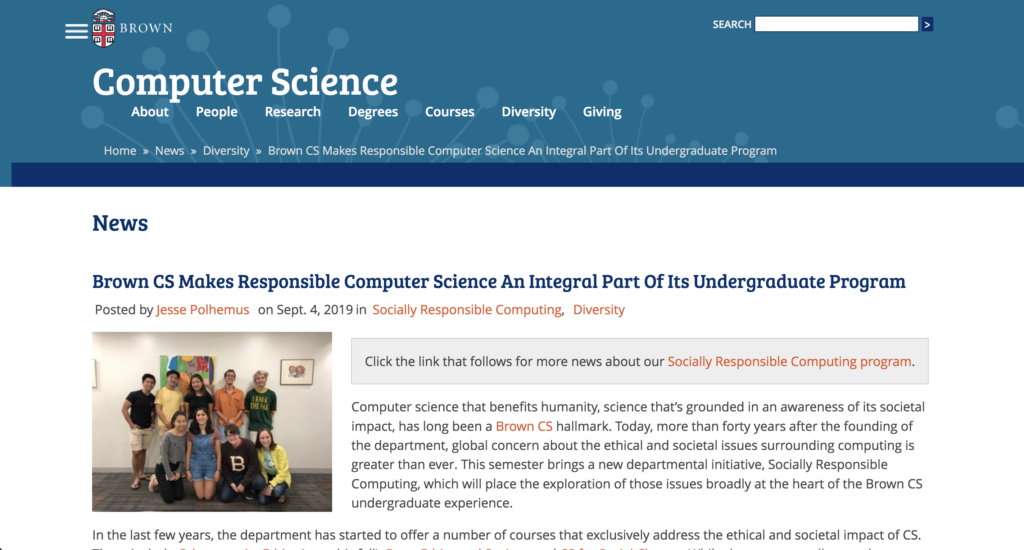
Announcement of socially responsible computing program, Brown Computer Science Department. The program adds special ethics and social impact courses, as mentioned in the announcement here, as well as embedding specially trained STAs (tbds) in computing courses on other topics. Courtesy of Brown University
Andy van Dam has led the way in promoting technology that serves humanity, infusing generations of computer scientists with his energy and vision of ethical tech that promotes the common good. And he isn't finished yet.
To participate in CHM's FREE September 23 event, Visualizing A Better Future: Celebrating CHM Fellow Andy van Dam, register here.
About the 2021 CHM Fellow Awards
The 2021 CHM Fellow Awards marks the Museum’s first-ever virtual Fellow Awards. CHM will celebrate the 2021 Fellows in a yearlong four-part series of thought-provoking virtual events and engaging digital content that explores the story and impact of each honoree and the present and future of tech for humanity.
Learn more about this year’s honorees and the 2021 Fellow Awards.
Headline Sponsor

Education Sponsors
